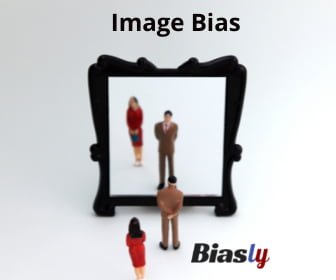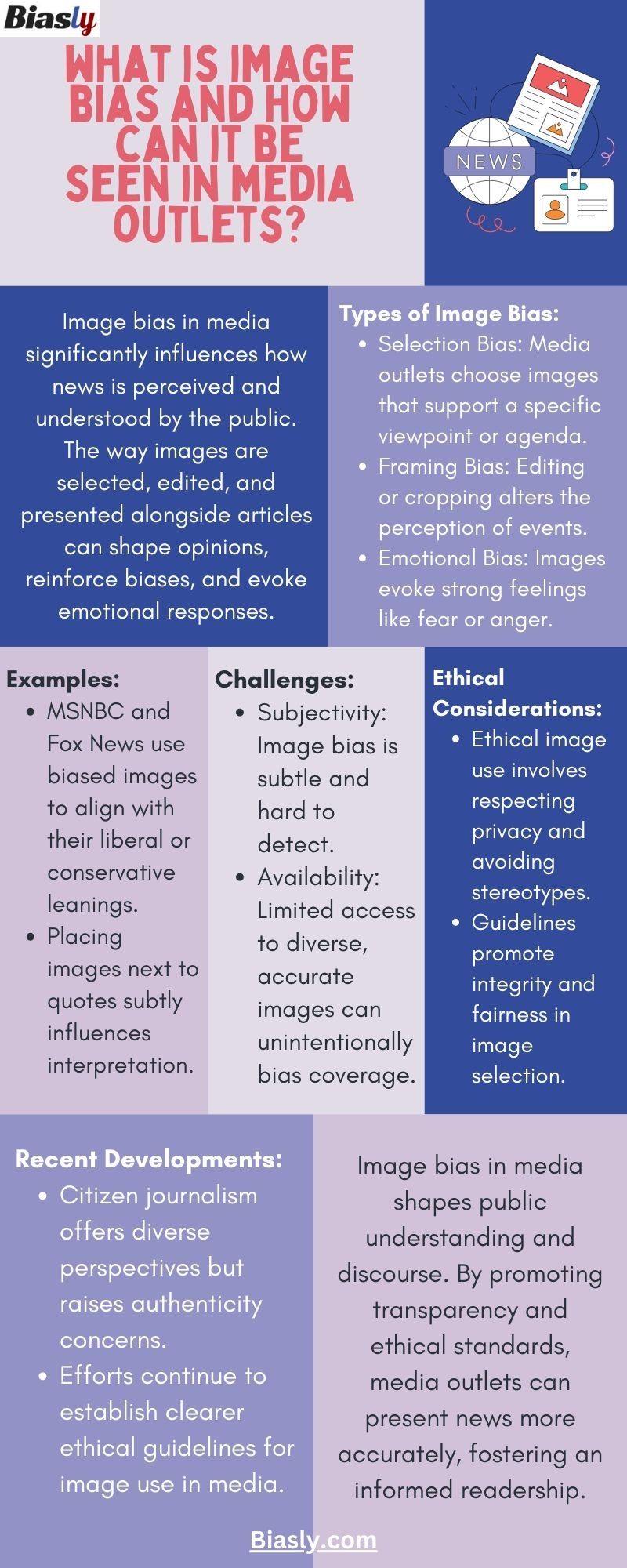
Image bias is a type of bias that occurs when images accompanying an article or news story influence the perception and interpretation of the content. Images have a powerful ability to shape our understanding of a topic and can influence our attitudes, beliefs, and emotions. The media and news outlets can use images to influence an article, which results in biased articles that promote certain narratives.
The use of images in media is often considered an essential tool in conveying information, attracting attention, and telling a story. Images are often used to add context, provide visual aids, and create an emotional response to the content.
However, the selection, editing, and presentation of images can significantly impact the overall tone and message of an article or news story. In different contexts, images can create different perceptions of how we see an event.
Types of Image Bias
One of the ways the media uses images to influence an article is by selecting images that support a particular viewpoint or agenda. This can occur when the media outlets have a particular bias or agenda they want to promote.
For example, a news article about climate change may include images of extreme weather conditions, such as hurricanes or wildfires, to evoke fear and concern in the reader. This may lead the reader to believe that climate change is an imminent threat that requires immediate action, thus promoting a specific narrative.
One example of a biased news source using an image to sway a reader in a specific direction can be seen in the example below:

Joe Burbank / Orlando Sentinel via Getty Images
MSNBC may be using this image of DeSantis looking somewhat upset with the words “Awake No Woke” behind him to sway the reader’s view of what is occurring and be framing a story in a certain way. The title of the article is “A New poll suggests Ron Destantis’ Anti-Woke Crusade Will Backfire.” The title, combined with the image shifts the readers’ perception of what is occurring and promotes a certain point of view.
Similarly, from Fox News, the image below shows Joe Biden in a scared or confused state to shift the view of the readers’ mind. The article “Newest political party on ballot in three states has democrats terrified” along with this image help shape the reader’s perception of what is occurring.

(Ting Shen / Bloomberg via Getty Images)
The news bias ratings from Biasly show that MSNBC has a very liberal bias.
Similarly, Fox News is shown to have a moderate to very conservative bias.
The images that each company shows to portray these figures are certainly supported by their bias ratings. Liberal media outlets show conservative figures in a negative way, and vice versa is also true.
Another way that image bias can occur is through the cropping and editing of images. This can involve selecting images that focus on some aspects while cropping out others, resulting in a particular interpretation of the event or situation.
For example, an image of a protest march may be cropped to focus on a specific group of people, making it appear as if the protest was more or less significant than what actually occurred. The way a camera captures a protest can certainly frame it as looking smaller or more significant than it actually was in reality, leading to false perceptions.
Image bias can also occur through the placement of images in relation to the article.
Image media bias can also be spotted in placing a graphic or image next to a particular quote or statement that can influence the reader’s interpretation of the quote. This can result in the reader associating the statement with the image, which may not accurately represent the content of the article. For example, putting a specific politician near an unrelated quote would impact the context and possibly lead the reader to think that the politician said that specific quote.
A Few Types of Image Bias
The use of images to influence an article can result in several types of bias, including confirmation bias, framing bias, and emotional bias.
- Confirmation bias occurs when the images used in an article support pre-existing beliefs or opinions, leading to a reinforcement of those beliefs.
- Framing bias occurs when the images used in an article shape the way a reader perceives the situation, leading to a particular interpretation.
- Emotional bias occurs when images are used to evoke a particular emotional response, such as fear, anger, or sadness, leading to an emotional reaction that may not be based on the facts.
Each of these biases above can lead to different perceptions that do not align with the truth. Here is a table that illustrates examples of these:
| Type of Bias | Description | Example |
| Confirmation Bias | Occurs when the images used in an article support pre-existing beliefs or opinions, leading to a reinforcement of those beliefs. | Selecting images of a political rally that only show supporters of one candidate and not the opposition. |
| Framing Bias | Occurs when the images used in an article shape the way a reader perceives the situation, leading to a particular interpretation. | Cropping an image of a protest march to only show a small group of protestors, rather than the larger crowd, to make it appear less significant. |
| Emotional Bias | Occurs when images are used to evoke a particular emotional response, such as fear, anger, or sadness, leading to an emotional reaction that may not be based on the facts. | Using images of violence or destruction in a news article to elicit fear in readers, even if those images are not representative of the overall situation. |
Challenges in Addressing Image Bias
One of the significant challenges in addressing image bias is that it can be challenging to detect within media. Unlike text-based biases, which are often easier to identify and correct in many circumstances, image bias is often more subtle and can occur without the reader recognizing it due to their biases.
Additionally, the use of images in the media is often subjective, making it challenging to establish clear guidelines or rules for their use when attempting to identify bias in images.
To address image bias, it is essential to recognize its existence and be aware of the potential impact that images can have on the reader. Media outlets should strive to select images that accurately represent the content of the article, rather than images that support a particular agenda or viewpoint. Editors and journalists should also be mindful of the cropping and editing of images, ensuring they are not used to misrepresent the situation or event.
Availability of Images
In addition to the ways that image bias can occur, there are also factors that can influence the use of images in media. One of the primary considerations is the availability of images.
News outlets often rely on stock images or images from press agencies to accompany their articles, rather than sending their own photographers to the scene. This can limit the accuracy of the photos used as there may not be an appropriate image available that perfectly encapsulates what the writer is attempting to get across.
One example of this is a small media company only having only a single source of stock images that does not include an image that the author of an article may need. This can lead to unintentional bias and incorrect perceptions of a news story.
Another consideration is the size and resources of the media outlet. More prominent media outlets with more significant resources may have access to a broader range of images and the ability to commission original photography. This can lead to a higher quality of images and more control over their use, but it can also result in a bias towards particular types of stories or events that the media outlet deems more newsworthy.
The use of images in media can also have significant ethical implications. The selection and use of images can impact the privacy and dignity of individuals, particularly in the case of sensitive or traumatic events.
Images can also be used to sensationalize or trivialize serious events, leading to a lack of respect or empathy for those affected.
In more recent years, there have been efforts to address image bias in media. One approach is through the use of guidelines and codes of ethics for the use of images, such as those established by the National Press Photographers Association or the Reuters Handbook of Journalism. These guidelines emphasize the importance of accuracy, respect for individuals, and avoiding the use of images that perpetuate stereotypes or misrepresent the situation.
Another approach is through the use of citizen journalism and user-generated content. With the widespread availability of smartphones and social media platforms, individuals can capture and share their own images and stories, providing a more diverse and authentic perspective on events. However, this approach also raises concerns about the accuracy and reliability of user-generated content, as well as the potential for the spread of misinformation or fake news.
Image bias is a significant concern in media and can have a powerful impact on the interpretation and understanding of news and events. The use of images in media is complex and multifaceted, and there are many factors that can influence their selection and use.
Addressing image bias requires awareness and vigilance on the part of journalists, editors, and media outlets, as well as the development of ethical guidelines and codes of conduct for image use. Ultimately, the goal should be to use images in a way that accurately represents the content of the article and respects the privacy and dignity of individuals instead of forcing agendas and framing events inaccurately.























